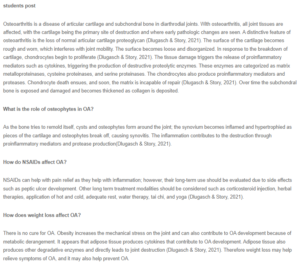Discussion Response – Osteoarthritis
Great post! I liked how you simplified and explained the concepts of osteoarthritis. To add to your insightful discussion, osteophytes can also enable physicians to distinguish osteoarthritis from different types of arthritis (Wong et al., 2016). Prolonged use of NSAIDs is highly discouraged due to the negative effects on the stomach, heart, liver, and gastrointestinal tract. In worst-case scenarios, the use of NSAIDs can lead to death (Hauser, 2010). Obese patients suffering from osteoarthritis have shown immense improvement, especially in the relief of pain—the pain relief results from the reduction of body weight that weighs on the joints. To promote weight management, physical exercise is encouraged. Older patients have specifically recorded significant improvements after participating in different types of physical exercise for at least three months. Their physical performance, cases of disability, and pain relief are common observations among the population. Some recommended physical exercises include bicycle training and water-resistive activities, which are of low impact. These activities improve the tone and strength of the peripheral muscles and cardiovascular system endurance without leading to any injuries that may result from excessive pressure on the joints (Johns Hopkins Arthritis Center, 2021). Thus, all osteoarthritic patients should embrace physical exercise for weight management as opposed to relying on NASDs. Our assignment writing services will allow you to attend to more important tasks as our experts handle your task. Get in touch with us at eminencepapers.com.
References
Hauser, R. A. (2010). The Acceleration of Articular Cartilage Degeneration in Osteoarthritis by Nonsteroidal Anti-inflammatory Drugs. Journal of Prolotherapy, 2(1), 305-322.
Johns Hopkins Arthritis Center. (2021). Osteoarthritis: Treatment. Retrieved from Johns Hopkins Arthritis Center: https://www.hopkinsarthritis.org/arthritis-info/osteoarthritis/oa-treatments/
Wong, S. H. (2016). Review Article: Osteophytes. Journal of Orthopaedic Surgery, 24(3), 403-410.
ORDER A PLAGIARISM-FREE PAPER HERE
We’ll write everything from scratch
Question
Discussion Response – Osteoarthritis
students post
Osteoarthritis is a disease of articular cartilage and subchondral bone in diarthrodial joints. With osteoarthritis, all joint tissues are affected, with the cartilage being the primary site of destruction and where early pathologic changes are seen. A distinctive feature of osteoarthritis is the loss of normal articular cartilage proteoglycan (Dlugasch & Story, 2021). The surface of the cartilage becomes rough and worn, which interferes with joint mobility. The surface becomes loose and disorganized. In response to the breakdown of cartilage, chondrocytes begin to proliferate (Dlugasch & Story, 2021). The tissue damage triggers the release of proinflammatory mediators such as cytokines, triggering the production of destructive proteolytic enzymes. These enzymes are categorized as matrix metalloproteinases, cysteine proteinases, and serine proteinases. The chondrocytes also produce proinflammatory mediators and proteases. Chondrocyte death ensues, and soon, the matrix is incapable of repair (Dlugasch & Story, 2021). Over time the subchondral bone is exposed and damaged and becomes thickened as collagen is deposited.

Discussion Response – Osteoarthritis
What is the role of osteophytes in OA?
As the bone tries to remold itself, cysts and osteophytes form around the joint; the synovium becomes inflamed and hypertrophied as pieces of the cartilage and osteophytes break off, causing synovitis. The inflammation contributes to the destruction through proinflammatory mediators and protease production(Dlugasch & Story, 2021).
How do NSAIDs affect OA?
NSAIDs can help with pain relief as they help with inflammation; however, their long-term use should be evaluated due to side effects such as peptic ulcer development. Other long term treatment modalities should be considered such as corticosteroid injection, herbal therapies, application of hot and cold, adequate rest, water therapy, tai chi, and yoga (Dlugasch & Story, 2021).
How does weight loss affect OA?
There is no cure for OA. Obesity increases the mechanical stress on the joint and can also contribute to OA development because of metabolic derangement. It appears that adipose tissue produces cytokines that contribute to OA development. Adipose tissue also produces other degradative enzymes and directly leads to joint destruction (Dlugasch & Story, 2021). Therefore weight loss may help relieve symptoms of OA, and it may also help prevent OA.
References
Dlugasch, L., & Story, L. (2021). Applied pathophysiology for the advanced practice nurse (1st ed.). Jones & Bartlett Learning.
- Length: A minimum of 200 words per post, not including references
- Citations: At least one high-level scholarly reference in APA per post from within the last 5 years

